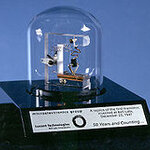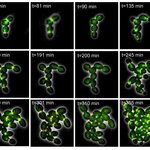Genetics & Molecular Biology

Will we ever have a set of standardized biochemical devices that synthetic biologists can snap together to make more complex systems? I'm skeptical that any single standardized biological device will hold up well under very different cellular contexts, without a lot of trial-and error modifications. We may successfully end up with a few really useful parts, but I'm betting that ultimately the catalog of useful and widely functional parts is going to be limited.
I think synthetic biology will always need customized parts or modules, even if those parts follow certain general design principles…

Engineering A Biological Pulse Generator
I've got my issues with synthetic biology. Either synthetic biologists do something trivial dressed up in elaborate engineering language, or they achieve something impressive and complex the old fashioned way (the way molecular biologists have been doing it for decades) - genetic engineering through trial and error, with very little principles-based engineering involved.
What I want to see is a result that falls somewhere in between these two extremes: genetic engineering that's non-trivial, but not so complex that it's impossible to use simulation and…

With hot, new technologies, biologists are taking higher-resolution snapshots of what's going on inside the cell, but the results are stirring up controversy. One of the most interesting recent discoveries is that transcription is everywhere: DNA is transcribed into RNA all over the genome, even DNA that has long been thought to have a non-functional role. What is all of this transcription for? Does the 'dark matter' of the genome have some cryptic, undiscovered function?
Unfortunately, in all of the excitement over possible new functions, many biologists have forgotten how to frame a null…

As you know, when different species directly compete for the same finite resource, only the fitter will survive. A new study in Proceedings of the National Academy of Sciences (PNAS) says they have demonstrated that in a laboratory environment, along with how, when given a variety of resources, the different species will evolve to become increasingly specialized, each filling different niches within their common ecosystem.
On the voyage of the HMS Beagle, Darwin collected and studied different species of finches on several of the Galapagos Islands. The finches differed in their…

Genome sequencing is getting better and faster. Two months ago we had the first draft of the neanderthal genome and now scientists from the University of Maryland have published their assembly of the Bos taurus - the domestic cow. Sure that's not as exciting to the wider population but it's important to the genetics community.
The research team led by Steven Salzberg developed special-purpose software to assemble 35 million DNA sequence fragments into the 30 chromosomes that make up the Bos taurus genome. The algorithms use paired-end sequence information, mapping data, and…

The circadian clock coordinates physiological and behavioral processes on a 24-hour rhythm, allowing animals to anticipate changes in their environment and prepare accordingly.
Scientists already know that some genes are controlled by the clock and are turned on only one time during each 24-hour cycle but now researchers at the University of Pennsylvania School of Medicine and the Salk Institute for Biological Studies have found that some genes are switched on once every 12 or 8 hours.
That means shorter cycles of the circadian rhythm may also biologically encoded. Using a novel time-sampling…

Sigh - I was going to recommend this piece about recent human genome research in Scientific American, by a leading researcher in comparative genomics, Katherine Pollard, until I came to the last paragraph:
Experimental and computational studies now under way in thousands of labs around the world promise to elucidate what is going on in the 98.5 percent of our genome that does not code for proteins. It is looking less and less like junk every day.
Anyone, especially a genome scientist, who implies that most of our genome is packed full of functional sequences should back that up with some…

Drs. Fred Cross and Eric Siggia have produced a steady stream of outstanding systems-level studies of one of the most important biological oscillators: the cell division cycle. I'll have more later today on their fascinating new paper on phase-locking the cell cycle, but in the mean time, check out their recent methods paper, which has some great movies of live-imaged yeast cells doing various cell cycle tricks, visualized with fluorescent proteins:
Here, we report a novel microfluidic setup for yeast that uses a dialysis membrane to separate the cells from the external flow. It provides…

Down syndrome is one of about twelve identified chromosomal disorders- some of which are caused by additional chromosome, in whole or in part. With Down syndrome, that extra chromosome is added to the 21st chromosome during fetal development. Down syndrome is also known as Trisomy 21.
Chromosomes are strands that contain DNA and protein which are necessary for cell division and genetic diversity.The syndrome was given recognition by Dr. John Down in 1866. The cause of why Down syndrome occurs was not discovered until the 1950s.
In the United States, there are about a half a…

Health and death have genetic risk factors. International research has linked ten gene variations to sudden cardiac death (SCD). What is SCD? It is death resulting from an abrupt loss of heart function -- cardiac arrest. Was this perhaps what the first famous poly-marathoner suffered?
Recent - The American Heart Association (AHA) says about 850 Americans die each day without being hospitalized or admitted to an emergency room. Most are sudden deaths caused by cardiac arrest. Death occurs within minutes after symptoms appear. Yet this health problem…